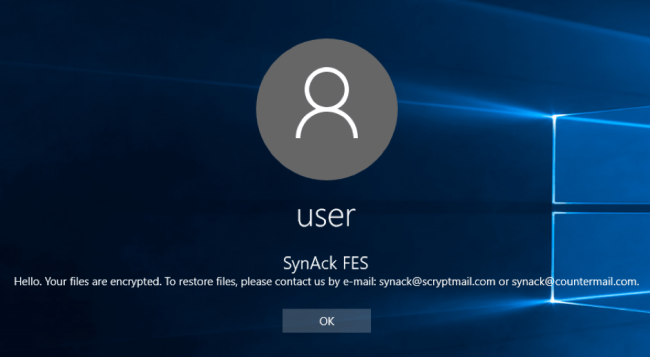What is SynAck?
SynAck is newly released variant of ransomware virus that encrypts files on infected computers. There are multiple versions of SynAck Ransomware, the first one has been spotted in September 2017. But it is that version which attracted the most public attention. The thing is that it’s the first ransomware virus that employs a sophisticated mechanism, called Process Doppelgänging, allowing to bypass detection of modern security systems. Using the new technique, it injects malicious code into NTFS transactions to trick the system and make malicious processes look like legitimate ones. To encode data, SynAck Ransomware uses combo AES-256+ ECC-SECP192R1 encryption algorithms that require a unique key for data release. The ransomware appends all affected files with a randomly generated extension containing 10 characters, for example, myfamily.jpg is changed to myfamily.jpg.TfQFi2cQbL. Upon completion of encryption procedure, it places a ransom note on Windows logon screen:

Here is used a typical scheme of all ransomware-type viruses – to make victims pay them. The only differences between them are the ransom price and encryption method. Cybercriminals state that there are no ways to recover your files but to pay a ransom. Once payment is done, they are supposed to send you decryption key. But you should know that nobody can guarantee that they will fulfill their end of the bargain. The practice shows that cyber-criminals just ignore people who paid them. That’s why you should not be pushed about by them because you can remain without money and files. On the contrary, you only may encourage them to continue their dirty business. In any case, you will be simply scammed. That’s why there is no need to contact them, it wouldn’t help. Still, SynAck ransomware does very complicated encryption, but it does not damage, move or delete your files, which means you have a chance to restore your personal data, but for now, you should focus on removing SynAck ransomware.
How to remove SynAck from your computer?
It scans your computer and detects various threats like SynAck, then completely removes it. One of the best features of this program – large threat’s database. SpyHunter’s newly advanced ransomware detection technology is able to run an instant ransomware scan and show you a message about detection. After deep scanning of your system, it will easily find and delete SynAck. Use this removal tool to get rid of SynAck ransomware for FREE.

How to decrypt files encrypted by SynAck?
Recover data with Data Recovery

- Download and install Data Recovery
- Select drives and folders with your files, then click Scan.
- Choose all the files in a folder, then press on Restore button.
- Manage export location.
Decrypt files manually
NOTE: Some variants of SynAck are easy to decrypt, just type: “VgjRPoOM0oa92_jId!/wkMeW6,guuSe” without quotes in the program window.
You can try to use one of these methods in order to restore your encrypted data manually.
Restore data with Windows Previous Versions
This feature is working on Windows Vista (not Home version), Windows 7 and later versions. Windows saves copies of files and folders which you can use to restore data on your computer. In order to restore data from Windows Backup, take following steps:
- Open My Computer and search for the folders you want to restore;
- Right-click on the folder and choose Restore previous versions option;
- The option will show you the list of all the previous copies of the folder;
- Select restore date and the option you need: Open, Copy and Restore.
Restore the system with System Restore
You can always try to use System Restore in order to roll back your system to its condition before infection infiltration. All the Windows versions include this option.
- Type restore in the Search tool;
- Click on the result;
- Choose restore point before the infection infiltration;
- Follow the on-screen instructions.

